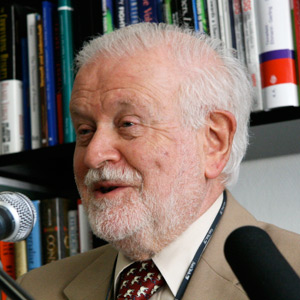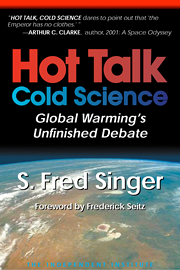Global warming has re-entered public consciousness in recent days, partly because of the buzz surrounding the release of warming results from the Berkeley Earth Surface Temperature (BEST) project. The reaction of the “warmistas” has been jubilant, yet hilariously wrong. Will they ever learn?
They’ve latched on to the BEST result as their last best hope for rescuing misbegotten schemes to control emissions of the greenhouse gas CO2. Leading the pack has been the Washington Post (Oct. 25), whose columnist tried to write off Republican presidential candidates Bachmann, Cain, and Perry as “cynical diehards,” deniers, idiots, or whatever.
I sent the Washington Post a letter pointing out obvious errors, but I got a peculiar response. It turned out that they were willing to publish my letter, but not my credentials as emeritus professor at the University of Virginia and former director of the U.S. Weather Satellite Service. Apparently, they were concerned that readers might gain the impression that I knew something about climate.
Unfortunately, it has become expedient (for those who condemn CO2 as the cause of warming) to deride their opponents with terms like "climate deniers." A complacent and inattentive media has made the problem worse, by giving the impression that anyone who doesn’t buy the CO2 hypothesis doesn’t believe that climate changes, and hence is a total Luddite. Even the Wall Street Journal got carried away. Prof. Richard Muller, the originator and leader of the BEST study, complained to me that some eager editor changed the title of his op-ed (Oct. 21) to “The Case Against Global-Warming Skepticism” from his original “Cooling the Global Warming Debate.”
The (formerly respected) scientific journal Nature chimed in and announced in an (Oct. 26) editorial[i] that any results confirming “climate change” (meaning anthropogenic global warming —AGW) are welcome, even when released before peer review. Of course, we’ve known for many years that Nature does not welcome any contrary science results, but it’s nice to have this confirmation.
Their hearts filled with bubbling joy and their brains befuddled, none of the warmistas have apparently listened to the somewhat skeptical pronouncements from Prof. Muller. He emphasizes that the analysis is based only on land data, covering less than 30% of the earth’s surface and housing recording stations that are poorly distributed, mainly in the U.S. and Western Europe. In addition, he admits that 70% of U.S. stations are badly sited and don’t meet the standards set by government; the rest of the world is probably worse. He disclaims to know the cause of the warming found by BEST and favors naturally caused oscillations of the atmosphere-ocean system that no climate model has yet simulated or explained.
The fact that the BEST results agree with previously published analyses of warming trends from land stations may indicate only that there is something very wrong with all of these. There are two entirely different ways to interpret this agreement on surface warming. It might indicate important confirmation, but logic allows for an alternate possibility: since both results rely on surface thermometers, they are not really independent and could be subject to similar fundamental errors. For example, both datasets could be affected by urban heat islands or other non-global effects—like local heating of airports, where traffic has been growing steadily.
But the main reason I have remained a skeptic is that the atmosphere, unlike the land surface, has shown no warming during the crucial period (1978-1997), either over land or over ocean, according to satellites and independent data from weather balloons. And did you know that climate models run on high-speed computers all insist that the atmosphere must warm faster than the surface—and so does atmospheric theory?
BEST has no data from the oceans, which cover 71% of the planet’s surface. True, oceans are not subject to urban heat islands, but they have problems with instrumentation. It is very likely that the reported warming during 1978-97 is simply an artifact—the result of the measurement scheme rather than an actual warming. Anyway, supporting data don’t show any ocean warming, either.
And finally, we have non-thermometer temperature data from so-called proxies: tree rings, ice cores, lake and ocean sediments, stalagmites. Most of these haven’t shown any warming since 1940!
Contrary to some commentary, BEST in no way confirms the scientifically discredited hockey stick graph, which was based on multi-proxy analysis and had been so eagerly adopted by climate alarmists. In fact, the hockey stick authors never published their post-1978 temperatures in their 1998 paper in Nature—or since. Their proxy record suddenly just stops in 1978—and is then replaced by a thermometer record that shows rapid warming. The reason for hiding the post-1978 proxy data: it’s likely that they show no warming. Why don’t we try to find out?
None of the warmistas can explain why the climate hasn’t warmed in the 21st century, while CO2 has been increasing rapidly. It’s no wonder that Herman Cain, a former math and computer science major in college, says that “man-made global warming is poppycock” (New York Times, Nov. 12). He blames climate fears on “scientists who tried to concoct the science” and “were busted because they tried to manipulate the data.”
Mr. Cain is not far from the truth—at least when one listens to Rich Muller. Muller’s careful to make no claim whatsoever that the warming he finds is due to human causes. He tells us that one third of the stations show cooling, not warming. Muller admits that “the uncertainty [involved in these stations] is large compared to the analyses of global warming.” He nevertheless insists that if he uses a large enough set of bad numbers, he could get a good average. I am not so sure.
Muller thinks that he has eliminated the effects of local heating, like urban heat islands. But this is a difficult undertaking, and many doubt that the BEST study has been successful in this respect. Some of Muller’s severest critics are fellow physicists: Lubos Motl in the Czech Republic and Don Rapp in California. Somewhat harshly, perhaps, Rapp would change the study designation from BEST to “WORST” (World Overview of Representative Station Temperatures).
I am one of those doubters. While many view the apparent agreement of BEST with previous analyses as confirmation, I wonder about the logic. It might be a good idea if BEST would carry out some prudent internal cheeks:
- Plot number of stations used between 1970 and 2000 and make sure that there have been no significant changes in what I call the “demographics”: station latitudes, altitudes, or anything that could induce an artificial warming trend.
- I would pay particular attention to the fraction of temperature records from airport stations—generally considered among the best-maintained, but subject to large increases in local warming.
- I would also decompose the global record of BEST into regions to see if the results hold up.
Of course, the most important checks must come from records that are independent of weather station thermometers: atmospheric temperatures, ocean temperatures, and temperatures from non-thermometer proxy data. But even then, it may be difficult to pinpoint the exact causes of climate change.
I conclude, therefore, that the balance of evidence favors little if any global warming during 1978-1997. It contradicts the main conclusion of the IPCC—i.e., that recent warming is “very likely” (90-99% certain) caused by anthropogenic greenhouse gases like CO2.
And finally, what to do if CO2 is the main cause, and if a modest warming has bad consequences—as so many blindly assume? I am afraid that the BEST project and Muller are of no help.
On the one hand, Muller is dismissive of policies to control CO2 emissions in the U.S.—much less in his State of California. In an Oct. 31 interview with the Capital Report of New Mexico, he stated:
On the other hand, Muller told MSNBC’s Morning Joe (Nov. 14):... the public needs to know this, that anything we do in the United States will not affect global warming by a significant amount. Because, all projections show that most of the future carbon dioxide is going to be coming from China, India, and the developing world. ... [A]nything we do that will not be followed by China and India is basically wasted.
[W]e’re getting very steep warming ... we are dumping enough carbon dioxide into the atmosphere that we’re working in a dangerous realm, where I think, we may really have trouble in the next coming decades.
So take your choice. But remember—there is no evidence at all for significant future warming. BEST is a valuable effort, but it does not settle the climate debate.









